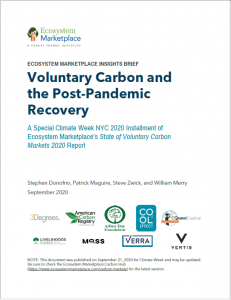State of the Voluntary Carbon Markets 2020
Voluntary Carbon and the Post-Pandemic Recovery
By Stephen Donofrio, Patrick Maguire, Steve Zwick, and William Merry View PublicationThis Insights Brief is the first installment in the State of Voluntary Carbon Markets 2020 series of analyses, to be published over several months in late 2020.
In this installment, we discuss key insights and findings garnered from Forest Trends’ annual 2020 Ecosystem Marketplace Carbon Survey cycle. Every year since 2006, Forest Trends’ Ecosystem Marketplace initiative has tracked, through its globally-recognized survey, what would otherwise be an opaque voluntary carbon market. The State of the Voluntary Carbon Markets reports have served as a consistent and comprehensive price discovery mechanism, while at the same time shedding light on the active project developers and intermediaries, thus answering fundamental questions about market dynamics, supply, and demand.
Companies worldwide are taking steps to eliminate greenhouse-gas emissions from their operations, but most find it’s either technologically impossible to eliminate all emissions immediately or that the costs of doing so are prohibitively high. In order to deliver deep and cost-effective reductions now, many companies have pledged to become carbon-neutral in the near term by financing emission-reductions elsewhere ̶ or, in climate parlance, “offsetting” any emissions they can’t yet eliminate. As a result, we are seeing near-record volumes being transacted in the voluntary carbon markets, despite the global COVID-19 pandemic.
Key Findings from the State of the Voluntary Carbon Markets 2020:
- Corporate carbon-neutral pledges fueled a record transaction volume of at least 104 MtCO2e in 2019, which is an increase of 6 percent over 2018. Figures may be adjusted with data from new respondents.
- Volume has been surprisingly strong in 2020. Anecdotal evidence based on interviews with market participants indicates it may even exceed that of 2019, despite the COVID-19 pandemic. Broader pledges have compensated for the loss of volume from the aviation and tourism sectors.
- Average offset prices remained flat in 2019, but with wide variance by type. Prices for offsets associated with Nature-Based Solutions (NBS) and Natural Climate Solutions (NCS), for example, increased 30 percent, while prices for offsets from renewable energy decreased 16 percent.
- Price and volume moved in opposite directions for these leading offset types. Agriculture, forestry, and other land use (AFOLU) volume dropped 28 percent and renewable energy volume surged by 78 percent.
- Despite the lower volume, the market value of AFOLU offsets was more than twice that of Renewable Energy, and demand for offsets associated with forest management in developing countries (i.e., REDD+) remains especially strong.

